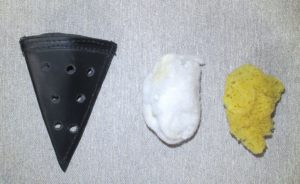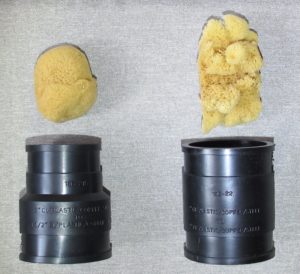Q: My embouchure gets tired, especially on long, soft, sustained passages. What can I do?
A: You have a couple of options:
- Try a cut reed.
- Try a much more closed tip opening. The more closed the tip opening, the better balanced of tuning is required.
- Narrow the reed shape, or try a narrower reed shape.
- Although it is normally not recommended to pull out the bocal, the added resistance of a slightly pulled out bocal can be beneficial.
- Use a bassoon mute for the softest passages (See below).
- See PDF, Seven B’s for Three ppp’s.
The mute on the left is a perforated, cone shaped leather bell mute purchased on the internet. You can also make a similar mute out of heavy felt. The middle mute is called a puff ball made from pillow stuffing. The mute on the right is a painter’s sponge. The puff ball or the sponge can be inserted inside the leather bell mute as needed or used independently. The sponge or puff ball can also be used at the top of a long joint for an additional choke of the sound. An example: if you are required to play the bass clarinet “solo” in Tchaikovsky, Symphony No. 6, movement 1 (below). Place the puff ball mute into the top of the long joint. Position it to cover half of the low C tone hole. A reminder: low D can be tuned down in pitch using the techniques found in Quick Guide to Bassoon Reed Tuning in Tests 5 and 6.
The contrabassoon mute on the lower left is a 1-1/2″ to 2″ plumbing pipe adapter with the metal clamp removed. On the lower right is a 2″ to 2″ plumbing pipe adapter with the metal clamp removed. These will fit snugly into the bell without slipping out which can be the case with a wash rag (or cloth rag) in the bell. In addition, the left mute will fit inside the mute on the right for an additional extension. Above these (left and right) are painter’s sponges that can be inserted loosely or tightly into the pipe adapter. An example of where a mute would be recommended is in Carmina Burana by Carl Orff. One of the latter movements requires super soft playing and without a mute is nearly impossible to play softly and in tune. It is also recommended to use a mute fingering for D.
Q: I have difficulty playing pianissimo when paired with clarinets. For instance, the opening to Tchaikovsky, Symphony No. 4. Is there anything that I can do to make this easier? I don’t have as much trouble playing pianissimo with oboes.
A: Bassoonist Bernard Garfield once said that you could hold the clarinet out the window of a slow moving car and it would make a tone! Clarinetists can easily slow down the air and produce a “sub-tone” which is a technique and frustrating factor for matching pianissimo. One solution is to ask the clarinets to use a more focused tone instead. Unfortunately for bassoonists the softer we play the more the tone tends to focus. To combat this, we can use mutes (see above) mute fingerings, or other tactics (see Seven B’s for Three ppp’s). One additional technique that can prove to “de-focus” the tone is to use “reverse breath support.” To accomplish this the abdominal muscles should be scrunched tightly inward. This can help spread and blend the tone with the clarinets. This technique can work with other instruments as well. The focusing of the tone is largely a result of the double reed closing the aperture and is a similar problem on the oboe while the flute can become breathy and unfocused like the clarinet. Complete tuning of the reed is essential as well as a leak free instrument.



